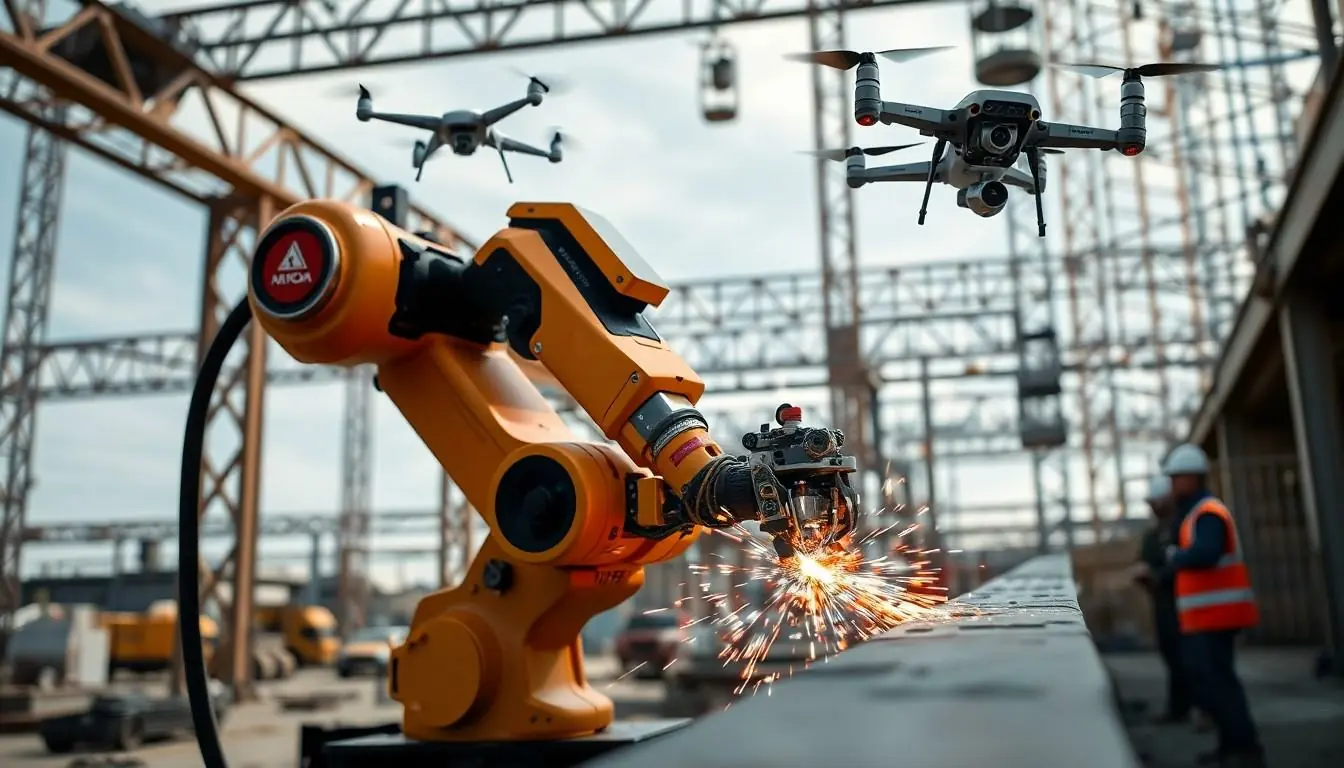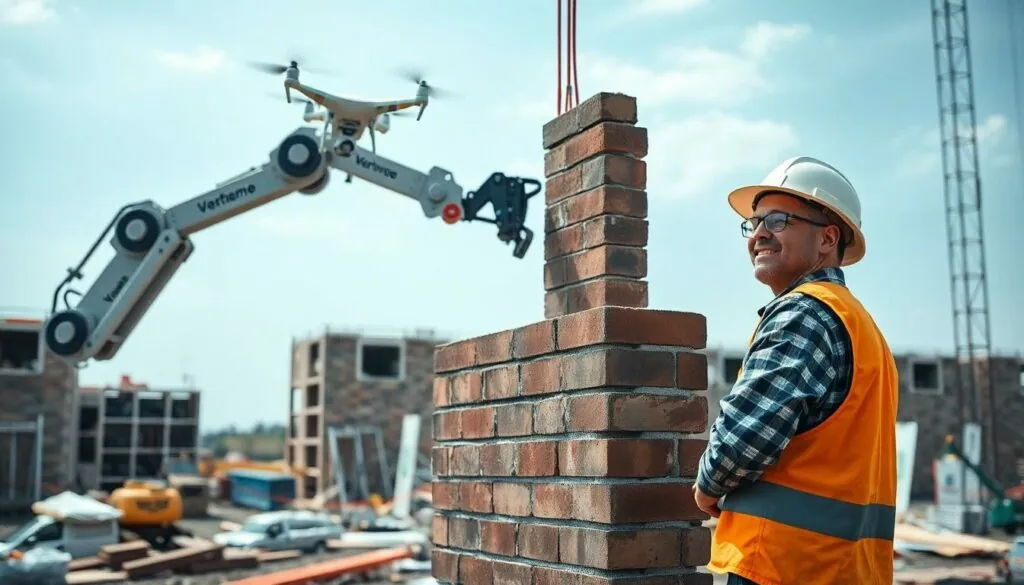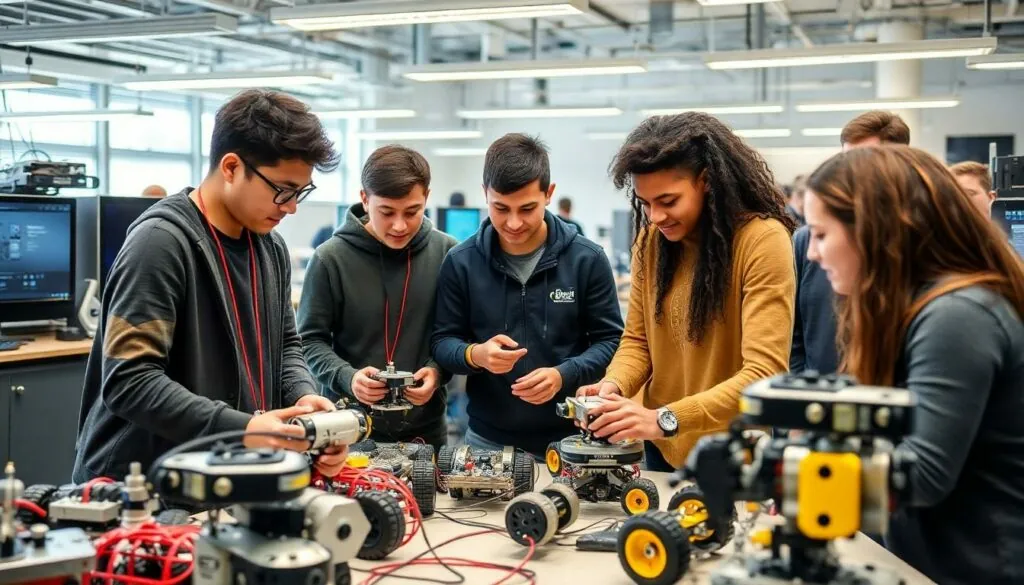In a world where hard hats and steel-toed boots are the norm, a new crew is stepping onto the construction site—robots! These high-tech marvels are not just for sci-fi movies anymore; they’re revolutionizing the way buildings go up and projects get done. Imagine a robotic arm that can lay bricks faster than a human can say “safety regulations.” It’s like having a super-powered sidekick who never asks for a coffee break.
As construction faces labor shortages and rising costs, robotics swoops in like a superhero, ready to save the day. From drones surveying sites to autonomous vehicles hauling materials, the future of construction is looking bright—and a little bit metallic. Get ready to explore how these innovative machines are reshaping the industry, making it safer, faster, and maybe even a bit more fun. After all, who wouldn’t want a robot buddy on the job?
Table of Contents
ToggleOverview of Robotics in Construction
Robotics is reshaping construction practices, introducing innovative technologies to improve various stages of building projects. Advanced machines, such as robotic arms, drones, and exoskeletons, provide crucial solutions to common industry challenges. Efficiency gains result from the precision and speed of these robots, allowing tasks to be completed far more quickly than traditional methods.
Robotic arms excel at repetitive tasks, such as bricklaying and welding. Drones offer aerial views to assist in site surveys and inspections, enhancing project oversight. They capture high-resolution images, enabling stakeholders to monitor progress and identify potential issues early.
Safety remains a primary concern, and robotics plays a vital role in mitigating risks. By deploying robots in hazardous tasks, companies protect human workers from dangerous situations. For instance, robots can handle materials in high-risk environments, like demolition sites or areas with toxic substances.
Labor shortages pose significant challenges in construction. The integration of robotics helps address this issue by streamlining workflows and relieving skilled workers from mundane tasks. Industry experts project a substantial increase in the adoption of robotics, further transforming the construction landscape.
Recent studies reveal that companies utilizing robotics see a reduction in construction timelines by up to 30%. Enhanced collaboration occurs between robots and human workers, leading to improved overall productivity. As robotics technology advances, it is likely to become the backbone of modern construction, ensuring efficient and safe project delivery.
Applications of Robotics in Construction

Robotics significantly enhances various applications in construction, improving efficiency and safety. This section discusses key uses that highlight the technology’s transformative potential.
Automated Machinery
Automated machinery plays a crucial role in modern construction projects. Robotic arms, for instance, execute repetitive tasks such as welding and painting with remarkable precision. These machines operate continuously, reducing labor costs and improving output. Manufacturers now produce mobile robots for site preparation and material handling. These robots help minimize delays and streamline workflows. Advanced software enables these machines to adapt to changing site conditions, further enhancing effectiveness.
Drones in Construction
Drones revolutionize construction site management by providing aerial perspectives for project oversight. These unmanned aerial vehicles conduct site surveys, capturing high-resolution images that support accurate mapping and planning. Inspection tasks benefit from drone technology, as it allows for rapid assessments of structures and land conditions. Data collected can identify potential issues before they escalate, saving time and resources. Construction companies report significant improvements in project timelines through effective drone integration, fostering real-time collaboration among teams.
Robotic Bricklaying
Robotic bricklaying systems elevate construction speed and precision. Specialized robots lay bricks consistently and accurately, achieving high-quality results. These machines can work alongside human crews, addressing labor shortages and enhancing productivity. By utilizing advanced algorithms, robotic bricklayers adapt to various designs and building specifications. Studies indicate that robotic systems cut construction time significantly, allowing for quicker project completion. The integration of this technology emphasizes the industry’s shift toward innovation and efficiency.
Benefits of Robotics in Construction
Robotics in construction offers numerous advantages that significantly impact building projects. Two major areas of benefit are increased efficiency and enhanced safety.
Increased Efficiency
Robots significantly reduce construction timelines. They complete tasks up to 30% faster than traditional methods, allowing projects to progress without delays. Robotic arms excel at repetitive jobs like bricklaying and welding with great precision. In addition, mobile robots assist with site preparation and material handling. These innovations minimize the time workers spend on mundane tasks, enabling skilled labor to focus on complex challenges. Automation streamlines workflows and improves coordination on-site, leading to overall higher productivity and timely project completion.
Enhanced Safety
Safety ranks as a top priority in construction, and robotics plays a critical role in addressing hazards. Robots engage in dangerous tasks, ensuring human workers remain out of harm’s way. Deploying drones for site inspections reduces risks associated with climbing scaffolding or navigating hazardous areas. Additionally, automated machinery can operate in extreme conditions, further protecting workers. Implementing these technologies not only reduces accidents but also fosters a safer work environment. Overall, the integration of robotics leads to a significant decrease in workplace injuries and improves safety standards in the industry.
Challenges and Limitations
Robotics in construction faces several challenges and limitations that impact its widespread adoption. Understanding these hurdles is essential for addressing them effectively.
High Initial Costs
Initial costs pose a significant barrier to the adoption of robotics in construction. Investments in advanced machinery and technology can require substantial financial resources, limiting access for smaller companies. Often, robotic systems come with high upfront expenses, including training and maintenance. These costs vary widely, with some robotic systems exceeding $100,000. Despite potential long-term savings through increased efficiency, many businesses hesitate to make such large investments upfront. Practical budgeting and financing strategies become crucial for fostering robotic integration.
Workforce Adaptation
Worker adaptation is another challenge that the construction industry must navigate. New technologies necessitate training and skill development for existing employees. Many workers might feel apprehensive about robotics taking over their jobs. As a result, workforce retraining programs become vital for ensuring a smooth transition. Employers must focus on reskilling their teams to work alongside robots, emphasizing safety and efficiency. Studies show that companies that invest in comprehensive training see a 20% improvement in employee retention and satisfaction. Hence, prioritizing workforce adaptation often leads to better collaboration between humans and machines.
Future Trends in Robotics for Construction
The construction industry is on the brink of revolutionary changes with advancements in robotics. Innovations in robotic technologies promise to enhance efficiency and safety significantly.
Innovations on the Horizon
Robotic construction technologies are moving toward greater autonomy. Robotic exoskeletons are becoming increasingly popular, allowing workers to lift heavy materials with ease. Modular construction systems will gain traction, enabling robots to assemble pre-fabricated components with precision. 3D printing is evolving, facilitating on-site construction of structures using innovative materials. Autonomous drones will expand their roles, mapping construction sites and performing inspections faster and more accurately.
Integration with AI and IoT
AI is leading the way in automating decision-making processes in construction. Construction robots equipped with machine learning can adapt to changing environments, ensuring seamless operations. IoT devices are enhancing connectivity, enabling real-time data sharing between robots and human workers. Enhanced monitoring of construction sites will lead to increased productivity and timely responses to potential issues. Integration of AI and IoT fosters smarter project management and improved resource allocation. Enhanced collaboration between these technologies will likely drive substantial advancements in construction practices.
Robotics is revolutionizing the construction industry by enhancing efficiency and safety. As technology continues to advance, the integration of robots into building projects will likely become more prevalent. Companies that embrace these innovations stand to gain a competitive edge while addressing critical labor shortages.
The collaboration between robots and human workers fosters a safer and more productive environment. By automating routine tasks, skilled labor can focus on more complex challenges, ultimately driving project success. As the industry evolves, ongoing training and adaptation will be essential to fully realize the benefits of robotics.
With promising trends on the horizon, the future of construction looks bright. Embracing robotics not only streamlines workflows but also paves the way for a more innovative and efficient industry.





